2010-05-03
Science of Imagination (in Ludwig Musem)
SCI-FI promenade at the other end of time ...
Ludwig Museum's new exhibition "Science of Imagination" is not only based on a theme but it's actually this theme that is being shown, this thought and all that it means including the whole era of Science-Fiction and so it as much as becomes an expression, a non-verbal 3-D multi-media essay, a complex installation ...
:::::: browse this article by chapters
::::: present calling the past, past calling the present
Ludwig Museum is so synonymous with contemporary art that this makes it an almost a weird act that this time they function as a traditional museum, showing something from the past that visitors can walk around and study, which is the Sci-Fi. But there's a twist, of course. The exhibits however are no remnants of an era, we can study sci-fi thru works by contemporary artists - of our very present. Yes, this is a contemporary Sci-Fi exhibition unfolding all that lays in this paradoxical situation.
Contributing artists are looking back on the age from where artists and scientists were looking into the future. Artists at the ends of a tunnel, you can say. At one and the other side of time. Curator of the exhibition Hajnalka Somogyi puts emphasis on this remarkable situation by opening a room for Chris Marker's cult sci-fi film La Jetée (which is the original of Terry Gilliam's 12 Monkeys) - from 1962.
(This film is about a mission, they want to send somebody back to the past and they need someone who has a very strong memory from then by which they can send him back - there's also a twist to it, as the strong memory is not just by chance, it involves quite a coincidence that ends up in a "loop", in an "endless reflections"-kind of phenomenon between the two panes of time.)

Sci-fi was the based on curiosity for the future, for what the outcome of all that was developing would once be. Future is thus the result, the solution of the puzzle that back than everybody would have liked to know like they wanted to know who killed Merilyn and the Kennedys.
It could have been that this exhibition sets our present as the future sci-fi was exploring - but not (!), what we see goes way beyond that and that's just the point this exhibition makes.
Our present is not the sci-fi future, we're already beyond that. We can't ignore the power of the numbers, just think of Space 1999, or 2001: A Space Odyssey or the Y2K problem and you'll see how 2000 would appear as a sort of end of normal time after which a completely new period is supposed to come, the space age, the ever dreamt "sci-fi age", the land of promises. As much as this deadline was important back then so is it important today -now that it became past that we've already left behind. We live in an age in which the future that we've been anticipating the most throughout history have just become a cheap and outdated tin of past.
We could as well feel a little deceived now that where we're supposed to find future it's only ourselves - this is what Adam Kokesch's Untitled work points out involving unopened tin-cans and open
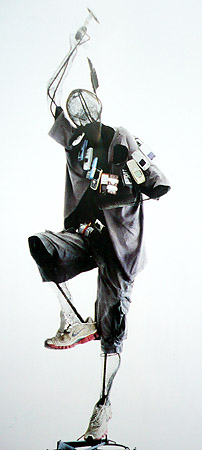 ones too, one of which a piece of onion grew out of. Sketches depicting planes scribed into window glass (plexi), arranged in a way that once must have had a reason now look like windows for the future, like cave drawings holding still the past dreaming of the future (it's ingenious in Kokesch's work that the sketches are scribed as if someone in a prison had done that with an edgy tool which emphasizing the tenacious yearning, anticipation for the future) . The tension in the composition derives from the grey metal stand's being unreasonably huge opposing the simplicity of a piece of onion in a time-capsule based puzzle and solution kind of context that is emphasized by open and closed tin-cans.
ones too, one of which a piece of onion grew out of. Sketches depicting planes scribed into window glass (plexi), arranged in a way that once must have had a reason now look like windows for the future, like cave drawings holding still the past dreaming of the future (it's ingenious in Kokesch's work that the sketches are scribed as if someone in a prison had done that with an edgy tool which emphasizing the tenacious yearning, anticipation for the future) . The tension in the composition derives from the grey metal stand's being unreasonably huge opposing the simplicity of a piece of onion in a time-capsule based puzzle and solution kind of context that is emphasized by open and closed tin-cans.
Pawel Althamer's self portrait as a "Sorcerer" reflects on this kind of deceivedness. It's quite a touching piece of art denying all the Sci-Fi utopias in an elegian way. As if saying: exploring the future? curious about the future? then face it, the future is past, definition of future is just that all that exists now will be gone later, that's it. Wanna see creatures never seen before? you want encounters? So here's quite a peculiar one. A human being who's frame is now being rotated as a cultural anthropological sample in the room so that everybody could see. An urban person, a young artist. These are the phones he used and these are his clothes and these are his shoes he used to wear. Anything else? A strange creature - strange for the strangers.
Using clothes, phones and shoes that he actually used to wear makes this piece like a modern version (beyond modern) of Van Gogh's shoe-paintings.
::::: the mission of Sci-Fi
It's an exaggeration however to talk about deceivedness, letdown and the dropped away sci-fi land of promises. Since sci-fi future often involved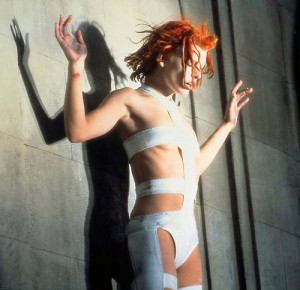 burning of the world future beyond sci-fi future has nothing to do with decadence, we survived. Although sci-fi comes from before, see Jules Verne or think of Leonardo da Vinci, it became in the col war era what we take it for even today. World's burning, the destructive or self-destructive nature of men had been a basic motif (not only The Fifth Element (1997) but even Age of Stupid of last year kept to this tradition).
burning of the world future beyond sci-fi future has nothing to do with decadence, we survived. Although sci-fi comes from before, see Jules Verne or think of Leonardo da Vinci, it became in the col war era what we take it for even today. World's burning, the destructive or self-destructive nature of men had been a basic motif (not only The Fifth Element (1997) but even Age of Stupid of last year kept to this tradition).
But who would call destructive human nature overreacted by sci-fi writers after the Holocaust (that's what Leeloo is shocked by) or in an era where the destructive arsenal was growing at a much higher rate then men's control over it - see Cuban Missile Crisis which probably ended because Khrushchev must have been aware that even a drunk soviet officer in Cuba could start the nuclear war, because he didn't have enough control over their own missiles.
Now this exhibition "takes place" some day after the big burn but in an other way, i.e. the world didn't burn, it's only the futuristic future that has melt away. Today both sci-fi and the future sci-fi was pointing to are simple past. Future-research, futurism now means a different thing. People still walk on the ground and no spaceships in the garage.
Sci-fi however is no failure, much rather it seems as a beautiful flower that came out from something ugly (the threat of global
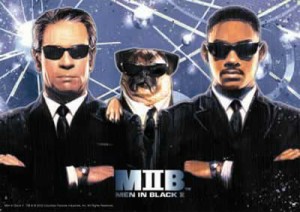 destruction), as a beautiful hypnosis that came from artists who wanted to stop what was going on in a wrong path. While in sci-fi stories human nature is destructive sci-fi itself actually helped mankind survive an era when we didn't have the sufficient control nor the sobriety over destructive powers. Si-fi served as an extra control that kept cold war cold all the time and got everybody involved in the great mission that is saving the world. Sci-fi was the good side of mankind which overcame the bad one. Sci-fi saved planet Earth. Hundreds of stories depicted intelligence, humanity, peace, peaceful evolution, respect for nature as the most admirable virtues while they looked down on destruction with the greatest disdain - which had its effect.
destruction), as a beautiful hypnosis that came from artists who wanted to stop what was going on in a wrong path. While in sci-fi stories human nature is destructive sci-fi itself actually helped mankind survive an era when we didn't have the sufficient control nor the sobriety over destructive powers. Si-fi served as an extra control that kept cold war cold all the time and got everybody involved in the great mission that is saving the world. Sci-fi was the good side of mankind which overcame the bad one. Sci-fi saved planet Earth. Hundreds of stories depicted intelligence, humanity, peace, peaceful evolution, respect for nature as the most admirable virtues while they looked down on destruction with the greatest disdain - which had its effect.
We collectively admired the perfect creatures as the heralds of the future and we kept breathing in the culture of the future, and of the higher level of conscience. Today it's obvious that it's been a "get to know yourself" - game (nosce te ipsum) the point in which is that one explores that self that s/he'd have become by the end of the road of exploration. Gabor Body who himself wrote a brilliant sci-fi story, the "Psychotechnicum" which involves a time-loop and "endless reflection" like the La Jetée once said in a similar context that "I am the dream of my life". Throughout the road of the get-to-know-yourself one 's dreaming of her/his future self, that's what's being developed. Sci-fi was something like this, we can say. We were exploring the future, zealous for UFO-s and strange creatures while we were actually developing ourselves as a picture in the darkroom. In the end it turns out that it's been us those mysterious strangers.
Sci-fi ever since Leonardo, thru 19th century and Verne and snce the 1960's has been pointing to a less and less far away future. Today sci-fi technically deals with our present which is only as much separated from our future as Achilles from the turtle: one phase, one step.
The day After Tomorrow (2004) rocked the world with the theory about the Golf-current and with that enormous crack when the giant iceberg broke off - which by the time of the movie's coming out became reality. There's Franny Armstrong's Age of Stupid from last year which is totally taking place in our present, however formally it operates with a sci-fi frame setting our present as the past viewed from the dark future when we're already past, only files in an archive from the age when we still "could have saved" our planet.
Although sci-fi future now happens to be very close to the present sci-fi still works in the traditional way as it always has (think of greatest movie success of 2010, The Avatar which depicts respect for nature and the living and disdain for destruction in the most powerful way ever in 3D).
We can say sci-fi has retained its future-exploring (pre-experience maker, decision-helper, effect-stud maker) intellectual activity. Still something has thoroughly changed, our relation to modern and modernity.
Sci-fi becme what it is at the climax of the modern age, but also sci-fi has been exploring the modern ever since Leonardo, searching for the futuristic, the future brand new, the future itself. Sci-fi has been the catalyst for the development of modern civilization, a catalyst, a guard, a guide, a herald and promoter too. Thru all those phases of time and history sci-fi projected the future, thousands of possible versions of it, all of them radiating with the respect for life and nature, disdain for destruction and humanity's supremacy over technical evolution.
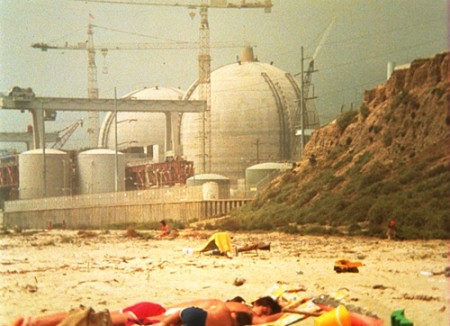
Sci-fi hasn't just been a funny fashion which by now became outdated, it's rather been an alternative channel of vital importance, a medium by which society otherwise prone to centralized mass media could stay under the benevolent influence of positive reason.
Sci-fi is no news of yesterday, what became outdated is only modern, the age of modern and modernity. End of modern was already obvious by the beginning of the 80's, Godfrey Reggio's film Koyaanisqatsi (1982) is already a huge warning indicating that technical evolution as it had been going on ever since Industrial Revolution is headed to a catastrophe, and the whole path is wrong.
It's actually amazing that although sci-fi was originally and traditionally obsessed with technics and evolution after a certain point it came off this orbit of modern and started to focus on survival, humanity, survival of humanity instead. This change however didn't happen in just a moment's time. Even as early as 1957 there was a sci-fi story about a robot sent back from the future to save the planet (Soldier from Tomorrow by Harlan Ellison whose sci-fi tv-films directly inspired the Terminator 1.)
The Day After from 1983 is quite a significant tv-movie showing explicitly what happens during nuclear war. "Nothing special" but the nuclear war, it wasn't even a real film but an illustrative educational, a spectacular demonstration - but it got to hundreds of millions worldwide and by its persuasive powers it modified our conscience in favour of defending life in an age in which Reagan invaded Granada only on the basis of the advice that a conflict modelling computer program gave them, and started a star war program.
Postmodern (which you couldn't exactly tell) was a great turn throughout which we collectively begin to see what modern, modernity and the modern evolution had been about and that this all was a wrong path. Terminator 1. as a cult sci-fi in 1984 was a simple time-travelling action-movie whereas Terminator 2. in 1991 was already a revolution, turning against the technical evolution stating that we became slaves of this evolution that we used to be masters of.
M. Night Shyamalan's Happening from 2008 is an explicit environmentalist warning, indicating that survival of Earth and nature became conflicting with survival of mankind. It is especially remarkable in this film that the threat and horror is represented by green plants, those that originally
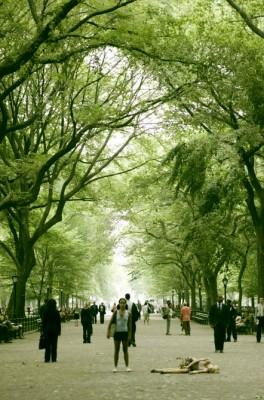 we're the most attracted to. Analogous to this is a music video seen by hundreds of millions worldwide thru MTV in 2004, a work by Uwe Flade for Depeche Mode's Enjoy the Silence (Linkin Park remix) in which it's a plant that causes the entire system to collapse, a horror story in which mankind is the bad guy.
we're the most attracted to. Analogous to this is a music video seen by hundreds of millions worldwide thru MTV in 2004, a work by Uwe Flade for Depeche Mode's Enjoy the Silence (Linkin Park remix) in which it's a plant that causes the entire system to collapse, a horror story in which mankind is the bad guy.
Postmodern by definition and by its function must last (have lasted) as long as we can already see the new era. Before it was much easier to recognize a new era since they all were like new models of the same product line, like new cars from the same factory. Postmodern was different however since this time we we left the original line and changed for a new one, according to the example the new model is not even a car car already but something totally different, a bicycle (and it's no more manufactured by the same old company either, and even manufacturing means a different thing, something opensource and non-profit).
This new era is about something totally different from which now we can already only see that it's practically the opposite to modern, it's non-modern. This opposition emerges along the problem "mankind vs. environment". While up to now spreading was the main preference (to the detriment of environment) now it's already sustainability (in favour of environment). While so far comfort, luxury, overriding of natural circumstances (heated terraces in winter, ice cubes in summer, air-conditioner) was prevailing and a greed for pleasures now it's getting to be ergonomy, evaluating life, drinking water and healthy life-style - this latter also as opposite to being fat.
There's a thousand frontiers but it's the same big GREEN turn, and the beauty of it is that what nature and survival makes us do is actually good for us, it results in a way healthier, happier, more enjoyable and more profound life. That is an ergonomic lifestyle. We are like addiction patients for whom rehabilitation is not a necessary bad thing, not a restriction but a possible start of a way more reasonable human life. This turn brings good for everyone that is why we even stand a chance that this thought (and all the acts unfolding from it) is going to spread at a revolutionary pace.
One of the climaxes of our modern ages was definitely that moment when Bush Jr. verbalized that US wages war for American lifestyle. The mere opposite to this became Franny Armstrong's Age of Stupid which makes it clear that it's exactly our lifestyle that we have to fight. Nevertheless Age of Stupid and COP 13 can be taken as the zero moment of the GREEN turn - by which we entered the age of non-modern.
Franny Armstrong's film and the 2009 Climate Summit also shed light on the greatest gift of this period, that is the power and human initiatives and civil organizations, and that man is no longer a tv-viewer who gets out to vote in every 4 years or so and then goes back to his cell again to keep watching, now it's the people down there who should tell what is going to happen at the high level of collective decision making, politics. This is the age of Facebook when society no longer consists of consumers living in their cells plugged onto central mass media but of people who can share and spread thoughts horizontally, organize, develop thoughts and make them happen. Today these movements and all initiatives coming from ground level, all the horizontal organizations play the same intellectual guarding role that sci-fi has been playing so far.
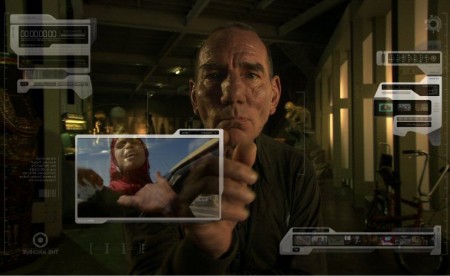
Age of sci-fi however is not over yet, but instead it's having a renaissance, the only thing that's different is that this is no longer the cold war sci-fi, the enemy is no longer the Russians. China is the new friend so we ran out of enemies (it's interesting to look at the series of enemies in the James Bond movies, the one before the last it was North-Korea but in the last one - it's hard to remember). No more enemies - thank god! In the Avatar the enemy is already mankind (and also the survivors are not humans).
The result is the new sci-fi, sci-fi after the GREEN turn, sci-fi without modernity, sci-fi in the non-modern spirit.
::::: Science of Imagination
What we see at the Science of Imagination exhibition is not really retro-futurism, but beyond that it's the new sci-fi already. Today's artists reflect on yesterday's sci-fi but not from the future that yesterday's sci-fi was pointing to but from one beyond that when sci-fi has already divorced the modern thought, when it's already non-modern.
Collapsist monument by Tamas Kaszas is an expression organized to the highest degree meanwhile it works like magic at the simplest level of expressions too (like when someone in the forest puts two twigs across expressing that a human was there). It's a complex expression being extremely elementary too.
As for its complexity the exhibition itself plays an active role too as what we see is not the actual work but a "pre-construction" of it. Even the phrase "pre-construction" has quite a meaning in the context of this exhibition where the La Jetée is being shown too.
There's more to it however. The "original" work is a shopping cart placed on green lawn having sledge feet instead of rollers. The contrast of the lawn and the sedge feet tells a story of a drastic climate-change already. Being acquainted to "history" however the past this sci-fi story refers to we can tell that shopping carts used to have rollers so even the change from rollers to sledge feet indicates a radical climate change. The exhibition itself adds to it too since it's not at it's original location, it's taken from there and now it's in the museum, somewhere else (the "cargo" style mounting tells the shipping's story).

Even the way of storytelling is quite remarkable - we see an archaeological artefact that we examine and make conclusions as archaeologists on the basis of a remnant from the past. This is really an original sci-fi situation, there was a catastrophe and now scientists at the location are trying to figure from traces what could have happened. This is an absolutely sci-fi story in which we are the scientists researching our own story. If blood or red colour is frightful because it's related to death, if passing is frightful then a shopping cart with sledge feet exhibited on lawn is the scariest icon of all. It's special about it that the end of consumer culture is connected to the green of the lawn and nature. Green and nature are supposed to be a happy ending but in this happy ending consumer culture is like a remnant of a fish washed ashore.
(note: in this work the basket part of the cart is a frail made of rushes which is a little bit distracting the above thought:))
This shopping cart however makes us remember a former piece of Ludwig Collection, still from the modern age. Duane Hanson, Supermarket shopper (1970) - a fat American woman with a shopping cart. It's not a painting, but physical reality, a super-realist-life-sized-sculpture as you see in a panopticum. Her clothes are original, as well as the products in her cart. This was a real sample from an age for the future, an imprint of consumer lifestyle. Had there just been a little more space aboard of Pioneer 10 then scientist sci-fi pioneer Carl Sagan could have sent this out together with the golden plaque. A message from planet Earth, this is what a human looks like.
Istvan Csakany's Bernsteinzimmer (Amber Room) alludes to the famous lost treasure of Friedrich Wilhelm 1st, where walls were all covered by figurative pieces of ambers. The special material for
 Istvan Csakany is wood. The message of the work is really complex.
Istvan Csakany is wood. The message of the work is really complex.
First of all we're stuck by the material, and by the strange fact that literally everything is made out of wood. The sight is like a sci-fi catastrophe scene as if everything was turned into wood (for some unknown reason, in some unknown way).
What really makes it an exciting sci-fi experience is that what we're looking at is like an imprint of a catastrophe. Since this wood is sort of white, everything is white, or rather duo-tone - without colours, only light and shadows - which intuitively reminds us of Pompeii as well as of a nuclear catastrophe.
This is confirmed by the fact that tools just lay there, like the work hasn't been finished, they must have been doing something when it all happened, when it all stoned - stoned into wood.
It's adding a philosophic depths to it that in a room which serves for woodworking all the tools that also serve for woodworking stoned into wood too. As if it was the vengeance of wood for the violent creatures who used to work it with violent tools. Now it was the wood that worked the workers.
This installation is a closed space which makes the one-time workshop appear as a prison cell, as well the one-time woodworking appear as pointless, since we see no product of the woodworking, we only see the consequences that everything stoned into wood.
Of, course, we can take it as someone made everything out of wood, a everything he made served woodworking. All in all this reminds us of Vonnegut's pieces of yeast, as they talk about the possible purposes of life and getting suffocated in what they are actually making - that is champagne, the original reason of their activity that can be only determined by deductive reasoning.
::::: Origami Space Race
The main object of the exhibition is by al
 means that huge helium balloon which is connected to a huge project - documented on a very small monitor next to it. This is where breaking from modern and modernity really gets confirmed at this exhibition. This is an actual space program which is not executed by the former default HQ-s of society like the army and NASA but by non-profit scientists, a free organization of them, working as a low budget, non-profit workshop that happens to be open-even source - that is, of course, the total opposite what we have so far experienced regarding space race and technical evolution in general.
means that huge helium balloon which is connected to a huge project - documented on a very small monitor next to it. This is where breaking from modern and modernity really gets confirmed at this exhibition. This is an actual space program which is not executed by the former default HQ-s of society like the army and NASA but by non-profit scientists, a free organization of them, working as a low budget, non-profit workshop that happens to be open-even source - that is, of course, the total opposite what we have so far experienced regarding space race and technical evolution in general.
In this project they send origami planes up to space, up to stratosphere (40 km), so these tiny paper planes are actual leading characters of a space program. The planes are launched up there by a mobile phone and then scientists will observe which developed plane flies better, they are trying to catch them by video camera and the are as happy to catch sight of an origami plane as the NASA to see a returning space shuttle.
A civil space program with minimal means, in an environment friendly way, in a friendly manner
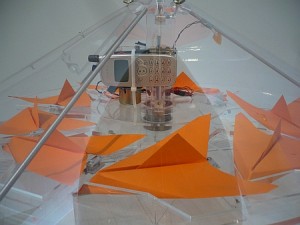 - in an open source workshop. Competition is friendly and it's the tiny planed that compete and not the superpowers who are threatening each other. Who would not call this a vision of a new period after cold war and the age of modern, based on an approach that is opposite to modern ...
- in an open source workshop. Competition is friendly and it's the tiny planed that compete and not the superpowers who are threatening each other. Who would not call this a vision of a new period after cold war and the age of modern, based on an approach that is opposite to modern ...
The Science of Imagination exhibition according to the spirit of the age is not exciting as a spectacle but rather as an exhibition of thoughts. Works are like thought-inspiring springboards, offering you a chance to jump, to jump off from modern and modernity and get acquainted to all kinds of new thoughts and start to get to know our next (present) brand new age ...
-Pilot Pirx-
2010-05-03


